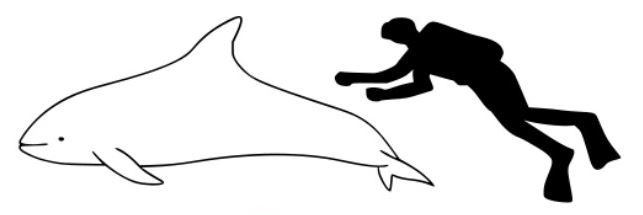White-Beaked Dolphin
LAGENORHYNCHUS ALBIROSTRIS

 2,5-3 metres
2,5-3 metres
 180-350 kg
180-350 kg
 Schooling fish, squid, octopi
Schooling fish, squid, octopi
 30-50 years
30-50 years

They are known to be very social, not only among each other, but also with other species such as the humpback and blue whale. They even have been spotted harassing whales to make them swim faster in order to create a wake for the dolphins to swim in.
At times, they can be quite playful around the boat, often dive under it, bow-ride or jump out of the water.
THE STORY OF THE WHITE-BEAKED DOLPHIN IN SKJÁLFANDI BAY
Oh, hello there! What’s up? Are you joining? We are the WHITE-BEAKED DOLHINS and just passing through. There is so much to see and do here in Skjálfandi Bay! Oh! Have you by any chance seen a humpback whale? We could make use of its position. It might have found some good food somewhere and lets us join the feast. You haven’t heard any rumours of small fish like haddock, herring, capelin, sand-eel in the area? Or even better, maybe squid? Not for nothing that we are also called the squidhounds. Anyway, we won’t delay you any longer, off we go!
Uhm, wait, actually, you’re making a funny wave there – look behind you! Do you mind if we bow-ride for a bit? No? Turn around guys, it’s playtime! Huiiiiiiiiiiiiii, look at me: I can jump so high and faaaaaar! Do you see all the patterns and colours on my body: the white beak (obviously giving me my name), the white belly and light grey stripes behind my dorsal fin and along the flanks? Look at my cousins and siblings: this complex colouration changes with time (as we age) so that our calves, juveniles and adults all look slightly different from each other.
Oh – you want to know more? How about this: we are one of very few dolphin species that live so far north. But we are well prepared as up to 30% of our body is made of blubber (a fat layer) that keeps us warm in these cold temperatures. We are quite big for dolphins, too, growing up to 3 metres long while weighing up to 300 kg.
As you can see, we travel in small groups, so-called pods, of between five to twenty individuals. While not always, our pods may be segregated by sex or age. All-male pods are referred to as an “alliance,” while an all-female pod is a “party.” However, other times we can be seen in so-called superpods, that is when we meet up with all distanced families.
How do we communicate? We use clicks and whistles and each dolphin has a slightly different tonal range, allowing other dolphins in the group to understand which one is communicating at the time. Our clicks and whistles are able to communicate a wide range of ideas: that a dolphin wants to mate, that there is danger, and that it has found food, for example.
The reason you came across us is that we like coastal waters, up to a depth of around 200 metres. But beware, we are always on the move and therefore appear all around Iceland.
Oh, are you on the move, too? Well, see you around, and please, let us know about that humpback whale if you find one. Even if there’s no fish, at least these giants are always fun to tease and bump into! It makes them do funny noises, stretch and splash around.
Other languages
Relative size to a human




